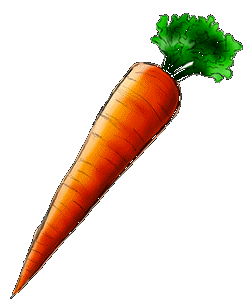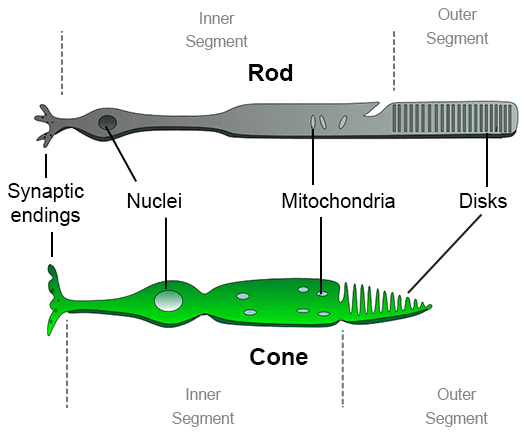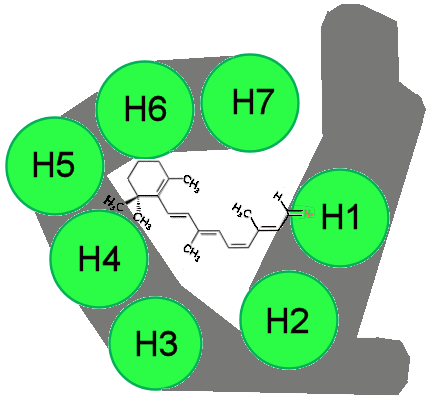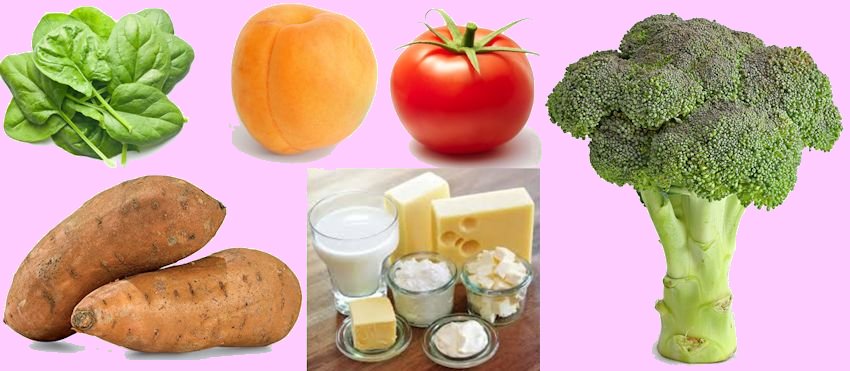![]()
Vitamin A
The molecule of vision
![]()
![]()
Molecule of the Month January 2017
(Updated July 2019)
Also available: HTML version.
![]()

Vitamin AThe molecule of vision
Molecule of the Month January 2017
|
 |
 You get that from eating carrots, right?
You get that from eating carrots, right?Yes, indirectly. Carrots contain the orange pigment β-carotene (see MOTM on carotene), which is also known as provitamin A. (A provitamin is a molecule that is a precursor to a vitamin). Enzymes in the body, notably in the small intestine, can split β-carotene molecules down the middle, producing two molecules of retinol (Vitamin A) which are then stored in the liver.
| |
|
|
Oxidation of retinol generates retinal, and when this is linked to a protein called opsin, it forms rhodopsin, a light-sensitive pigment. Rhodopsin is the pigment responsible for night-vision and allows you to see in black and white.
Yes, in the retina. The retina at the back of the eye contains two types of light-sensitive cells named after their shape - rods and cones. The type of rhodopsin found in the rod cells absorbs green-blue light strongly and so appear reddish-rosy-purple, which gave it its other name "visual purple", as well as its official name derived from the Greek (rhódon) for “rose-coloured” and (ópsis) for “sight”.
There are a range of other proteins called photopsins which also bind retinal, and these absorb different wavelengths of light (notably red, green or blue). These three main photopsins are found in the cone cells, and work together to produce full colour vision.
 Light moves through the lens of the eye (1) and is focused onto the retina (2). Here it is absorbed by rod and cone cells, which send a signal through nerve cells (3) which pass it into the optic nerve (4) and finally into the brain (5). |
 Rod and cone cells contain the rhodopsin and photopsin pigments, respectively, in the disks in their outer segments. |
| [Images: https://askabiologist.asu.edu/rods-and-cones] | |
So how does vitamin A help you see?The aldehyde group of retinal is bonded via a Schiff base linkage to the N of a lysine group in a pocket in the opsin protein, i.e. RC=N-{opsin}. When attached into the pocket of the opsin protein like this, the retinal molecule becomes light-sensitive, and acts like a light-sensitive switch. When light of the correct wavelength falls onto the rhodopsin, the retinal isomerises from the bent 11-cis-isomer into the straight all-trans-isomer.
|
 Top view of retinal bound into the pocket of opsin in the dark. Opsin is composed of 7 helices arranged in the shape of a hollow tube. The retinal bonds across the gap in the middle so that any change in shape or size of retinal will cause the entire protein to change shape too. In other words, a small twitch in the retinal causes a much larger twitch in the big protein. |
|
 |
||
This sudden straightening out of the small molecule in the pocket forces the surrounding large opsin to adjust its own shape by going through various structural rearrangements. Because the opsin is partly embedded in the rod cell membrane, near to sensitive nerve endings, when it ‘twitches’ it causes a signal to be sent down the nearest nerve cell to the brain, which we perceive as sight. Its job done, the opsin then ejects the irritating straight retinal molecule, and relaxes back to its normal shape, whereupon it can absorb another nearby bent cis-retinal again. The system is thereby reset ready for the next photon to arrive. The previously ejected trans-retinal is converted back to cis by enzymes, ready to be absorbed by any nearby empty opsins.
So if I eat lots of vitamin A my eyesight will improve?No, the idea that eating lots of carrots (which contain carotene) allows you see in the dark is an urban myth that was started by the British government during World War 2. During the night-time bombing attacks on London in 1940-41, some of the British airbourne night-fighters, such as the Bristol Beaufighter pictured below, were achieving surprisingly high levels of success in shooting down the German bombers – far more than should be possible considering they were literally flying in the dark. This was mainly due to the use of a secret airbourne radar which the Germans did not know about. To avoid suspicion, the rumour was deliberately started that the night-fighter pilots could see better in the dark because they ate a lot of carrots. People believed it, and it wasn't until long after the war had ended that the story of the secret radar was revealed. Yet the myth of carrots helping you to see in the dark still persists today. But we need some vitamin A, though?Yes, without consuming sufficient vitamin A various deficiency illnesses can arise. The first symptoms are a loss of night vision, but in more severe cases this can lead to complete blindness. In developed countries vitamin A deficiency is uncommon, especially now that many countries add vitamin A supplements to wheat flour. But in developing countries it is a major problem, especially for children and pregnant women. In 2005 the World Health Organisation (WHO) survey stated that about 1/3rd of children under five around the world suffered from some form of vitamin A deficiency. And somewhere between a quarter to half a million children went blind, with many of these then dying as a result. |
|
Was anything done about this?Yes, the United Nations, UNICEF, the WHO (not the rock group) and other aid agencies teamed up to provide free doses of vitamin A twice a year to children in developing countries. These doses prevented any deficiency in those children, and the work seems to have improved the worldwide situation greatly. The other great hope is Golden Rice. What’s that?It’s rice that has had the genes for making carotene inserted into its DNA. This rice is identical to normal rice, except that it is yellow not white, and now a very good source of vitamin A. Studies have shown that golden rice was as good as vitamin A supplements and better than the natural beta-carotene in spinach. However, because it is a genetically modified crop, its use is controversial and its use is being opposed by the usual anti-GM activist groups. |
|
Surprisingly, many green vegetables are high in Vitamin A, such as spinach, broccoli and kale, as well as some fruits like papayas, apricots, mangoes and tomatoes, but also some unexpected foods like sweet potatoes, milk, butter and eggs. Because vitamin A is stored in the livers of animals and fish, eating liver is an excellent source of this vitamin. Cod liver oil supplements used to be given to many schoolchildren daily in the 1970’s because it is an excellent source of vitamin A (and D, see MOTM on Vitamin D), although this practice has declined in recent years due to the fact that sufficient vitamins can be usually obtained from a balanced western diet.

Foods rich in vitamin A.
However, too much vitamin A is bad for you, as high levels of vitamin A cause a complaint known as hypervitaminosis A. This can be caused by eating the liver of some animals, notably the polar bear, husky, walrus and seal. Although this isn’t usually a problem for most people in the modern world, it can be an issue for Eskimos or polar explorers. In 1913, the Arctic explorer Xavier Mertz died after eating the liver of his huskies when his expedition ran out of food. |
|
|
Is there nothing I can eat that will improve my eyesight?Well, a new study suggests that other carotenoid molecules may help to regenerate some protective pigments in the eye. These molecules, but lutein, zeaxanthin and meso-zeaxanthin (see MOTM page for June 2007),, are related to carotene, and are yellow pigments found in plants such as corn, spinach, bell peppers, and saffron. In the eye they accumulate in the macula, a small area of the retina responsible for central vision. It is believed that these pigments absorb blue and UV radiation, preventing damage to the cells in the macula, a bit like a sunscreen for the retina. As we age, the concentration of these pigments in the eye decreases, leaving the macula less protected against UV damage. Preliminary studies indicate that eating supplements containing high doses of these molecules can may help slow or possibly even prevent, age-related macular degeneration (AMD) - the leading cause of vision loss in the UK. But much more work needs to be done before these findings are confirmed and the supplements available at your pharmacy. |
|
|
No, it serves other functions as well. A study in 2019 showed that it helps to regulates immune function through its derivative, retinoic acid. Retinoic acid is used by the body to control skin infection and inflammation. The study shows that consuming vitamin A allows the body to synthesise an antimicrobial protein in the skin which can kill bacteria by disrupting their membranes. The work explains why vitamin A analogs added to creams and ointments can effectively treat skin conditions such as acne and psoriasis.
|
![]()
![]()